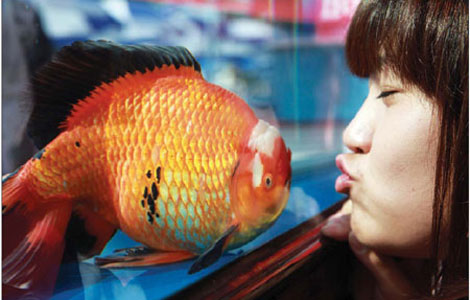Golden run ahead
Updated: 2011-02-25 11:19
By Liu Lu (China Daily European Weekly)
 |
|
A good goldfish should have a short and bulging body, say leading goldfish exporters. Chen Xiaogen / for China Daily |
Ornamental fish sales peak on rising domestic demand, exports to Europe
For over 1,000 years goldfish have been part of the Chinese culture and occupied the pride of place in homes and businesses. The dazzling ornamental fish is considered a symbol of wealth and prosperity in Chinese feng shui with some priced varieties commanding astronomical prices.
Unlike exotic pets that need a lot of pampering and care, goldfish are relatively easy to raise and look after. They are also seen as the ideal companions that help you relax with their graceful and dazzling movements.
Amid such popularity, it was only natural that there was public angst over magician Fu Yandong's magic trick in a recent CCTV program that had goldfish swimming in perfect formations to the blow of a whistle.
Animal rights groups dubbed the performance as an act of cruelty to these magnificent animals.
But business is also all about taking advantage of the opportunities.
The nian nian you yu show means "having a surplus every year", and has sparked off a goldfish boom that has left many petshop owners in China flummoxed as they are unable to cope up with the demand.
Goldfish, or jinyu in Chinese, is actually a genetic mutation of the Crucian Carp. It was domesticated in China more than 1,000 years ago and has since then commanded a key role in Chinese traditional culture and art.
In China, the goldfish is also dubbed the 'national fish'. Jin means gold, while yu has the same pronunciation as the word for bounty or surplus, making people believe it is a good omen that brings abundance, luck and success.
"After satiating their material demands, people often search for things that give them spiritual bliss," says Sun Yansheng, secretary general of the ornamental fish branch at the China Society of Fisheries.
"In this context, an increasing number of people are raising goldfish, not only for their graceful movements, but also because they represent joy and vitality, and help in easing the negative emotions of a fast-paced life."
Sun says goldfish is one of the earliest ornamental fish species and the most commonly kept aquarium fish. In the 1950s, Chinese leaders often presented Beijing Goldfish, a valuable goldfish species, as gifts to visiting foreign heads of states.
"Every goldfish is a 'living artwork' because of its poise and graceful appearance and the propitious meaning it bears," Sun says.
"A beautiful goldfish has vibrant colors, sharp color contrast and pattern distributions all over its body. But most importantly, a good goldfish should have a short and bulging body," says Chen Zhenping, general manager of Thung Hoi Aquarium Co, one of China's leading goldfish exporters from Dongguan in South China's Guangdong province.
"The quality of a goldfish directly determines its market price," says Chen.
The Hong Kong native developed a strong interest in goldfish breeding since the age of six. With 28 years of experience in breeding goldfish, Chen is today not only an expert in goldfish farming, but also has four goldfish breeding bases in Guangdong and Shanghai.
He has cultivated nearly 300 goldfish species so far, and exports over 5 million goldfish every year to Europe. It also accounts for nearly 30 percent of his company's total revenue.
"Many European families keep ornamental fish either in a pond or fish bowl," says Chen, saying that China began to export goldfish to Europe in the 1600s.
He says most of the Chinese goldfish are exported to Germany, France and Britain. Frankfurt is Europe's largest transit point for goldfish in Europe.
"People in Europe are particularly keen on Chinese goldfish as they are better looking and easier to raise compared to other ornamental tropical fish."
But along with the boom both at home and abroad, there was also a period when the species was under threat, as unscrupulous traders failed to take proper care of the fish.
"We are happy to see that in recent years, more and more farmers are paying attention to conservation for the birth of new species. This will gradually sharpen the competitiveness of Chinese goldfish in the international market," he says.
According to Chen, Chinese goldfish was introduced to Japan some 500 years ago. The Japanese have since then upgraded the variety of the imported fish and dominated the high-end overseas goldfish market till the 1990s.
Over the past two decades, though the efforts of fish breeders and marine scientists, China has gradually taken over the market from Japan. The nation is the biggest goldfish exporter in the world and exports some of the most exotic varieties.
Demand for goldfish has also been steadily going up in domestic markets especially after the CCTV show, say pet shop owners.
"Sales has been booming in the past few weeks," says Xu Yong, an ornamental fish retailer in Beijing who started the business on taobao.com, China's largest online marketplace in 2006.
Xu says he normally sells around 120 goldfish every month, but has already doubled that after the CCTV show.
The rising demand for goldfish has also led to an increase in the buyer profiles. Till some years back, the majority of goldfish buyers have been middle-aged or senior citizens. That has changed now and most of the new buyers are from the younger generation," says Xu.
Changing lifestyles and busy schedules are keeping many employees at home. Raising pets that are easy to look after and a comfort for tired eyes both at home and workplaces, perhaps best explains the goldfish craze.
"Watching the fish move freely in the tank helps soothe my tired eyes and also helps me to chill out," says Han Wei, a 27-year old web editor in Beijing.
"Putting a fish tank near you is also the simplest and most economical method to humidify the dry air," says Han.
The craze has spawned nation-wide ornamental fish competitions in several big cities like Beijing and Guangzhou.
"We hope these competitions will promote China's traditional culture and contribute to the revitalization of the Chinese goldfish industry, as well as provide science education to the younger generation," says Jia Li, the head of Beijing Aquatic Product Technology Promotion Department, who is also one of the organizers of the annual China Ornamental Fish Competition.
She says the event has attracted goldfish feeders from both home and abroad. This year, the goldfish competition will be held in September.
At present China's major goldfish breeding areas are in Beijing, Tianjin, Jiangsu, Zhejiang, Guangdong and Fujian provinces, with each region producing fish with distinct characteristics, says Chen Zaizhong, professor of the College of Fisheries and Life Science at the Shanghai Ocean University.
"In the light of the expanding ornamental fish market and people's soaring enthusiasm for keeping goldfish, government and enterprises have increased input in goldfish breeding, cultivation and species innovation to cope with the shoppers' varied tastes and skyrocketing market demand," Chen says.
He says the Shanghai Municipal Agriculture Commission has set up a goldfish resource base in 2010, to better protect and expand the species.
"Data shows that in big cities like Beijing and Shanghai, only 2 to 3 percent of the households keep goldfish, proving there is still much room for development of the ornamental fish market in China."
E-paper

Sindberg leaves lasting legacy
China commemorates Danish hero's courage during Nanjing Massacres.
Preview of the coming issue
Crystal Clear
No more tears
Specials

NPC & CPPCC sessions
Lawmakers and political advisers gather in Beijing to discuss major issues.

Sentimental journey
Prince William and Kate Middleton returned to the place where they met and fell in love.

Rent your own island
Zhejiang Province charts plans to lease coastal islands for private investments
